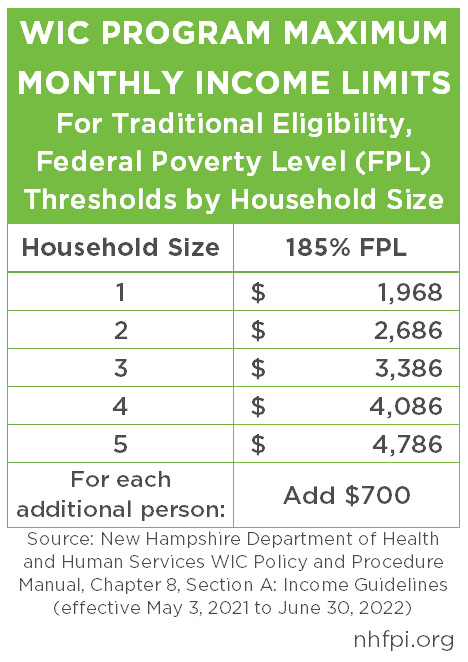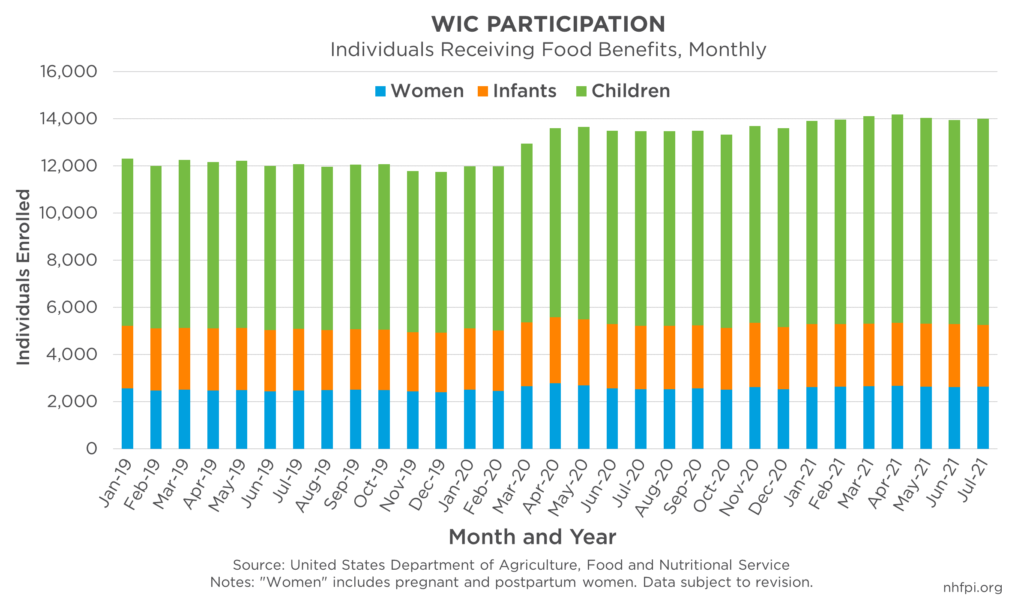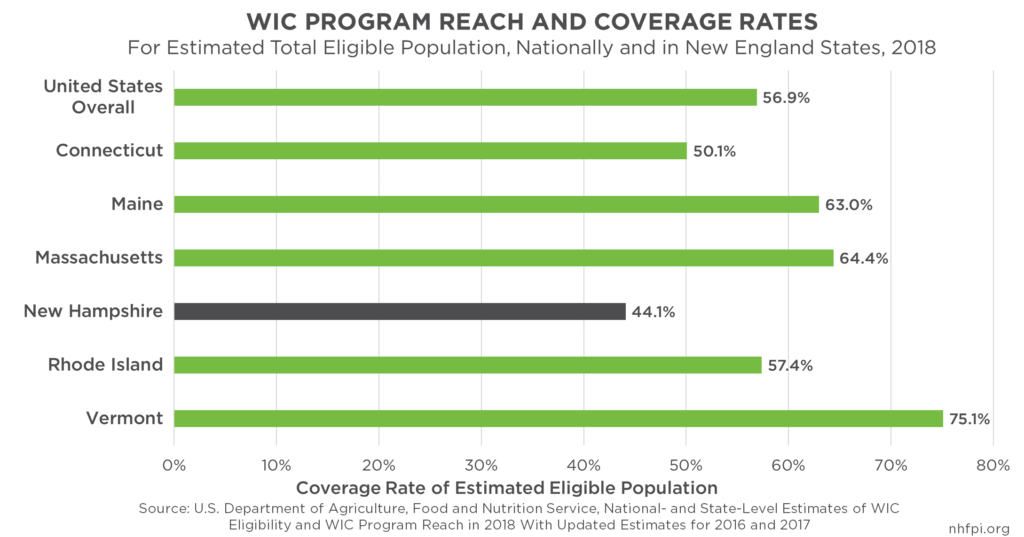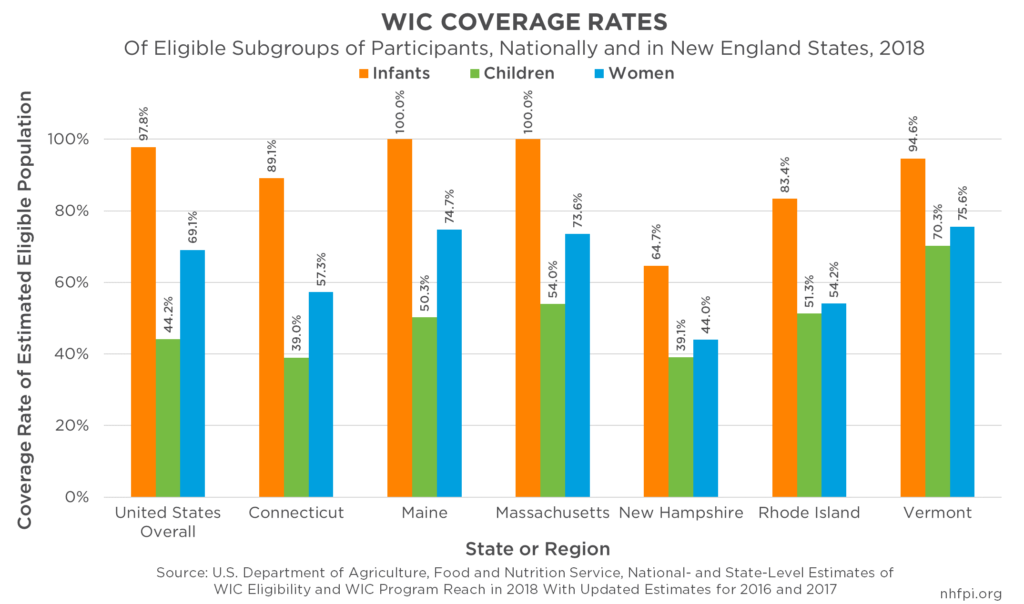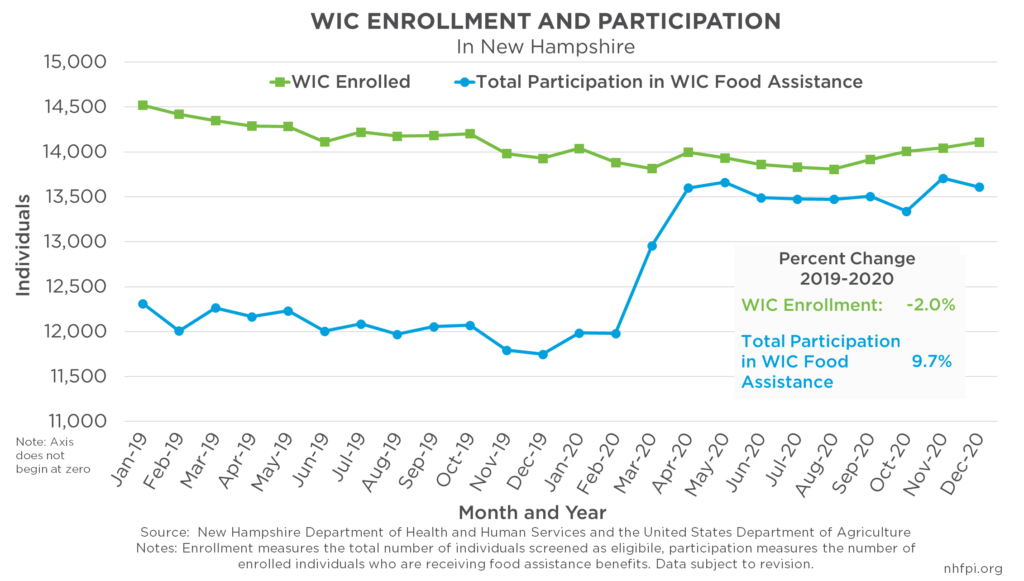The Special Supplemental Nutrition Program for Women, Infants, and Children (WIC) provides key nutritional aid, education and support, and healthcare referral services to eligible women, infants, and young children throughout New Hampshire and the nation. This program is targeted towards pregnant women and mothers with young children who have lower incomes and certain health or nutritional risks. Benefits include assistance purchasing nutritious foods, one-on-one or group nutrition education and counseling, and general support and resources that help improve the overall health, development, and economic security of participating women, infants, and young children.
All funding for the benefits and the administration of the WIC program are provided by the federal government and are dependent on regular federal appropriations and reauthorization.[i] This program has been one of the most successful federally-funded initiatives at improving the health and well-being of pregnant, postpartum, and breastfeeding women, as well as their infants and young children. Analysis compiled by the United States Department of Agriculture (USDA) found that every dollar invested in prenatal WIC participation saved more than a dollar in healthcare costs due to improved overall health.[ii]
In New Hampshire, average program participation totaled just over 12,000 individuals during 2019, of which 21 percent were women, 21 percent were infants, and 58 percent were young children.[iii] Prior to the pandemic, the WIC program may have reached less than half of the estimated eligible population in New Hampshire – lower than nearly every other state in the nation.[iv] This may indicate that, prior to the pandemic, the reach of the WIC program in New Hampshire was fairly limited compared to other states. The ongoing COVID-19 pandemic has increased hardships facing families, and the federal and state government implemented temporary WIC program changes aimed to reduce challenges or barriers for eligible participants. However, there still are many eligible individuals not participating who would benefit from the support provided by the WIC program.[v]
This Issue Brief discusses the WIC program, including benefits, eligibility, enrollment, and participation. Analysis in this Issue Brief examines the overall health and economic security improvements the WIC program provides and reviews the program’s reach and coverage rates of eligible populations in New Hampshire, other New England states, and the nation. Additionally, this Issue Brief considers the impact of the COVID-19 pandemic on enrollment, along with opportunities to improve the reach of the WIC program to provide critical aid and support to greater numbers of eligible women, infants, and young children throughout New Hampshire.
Program Overview and Eligibility
WIC serves pregnant and postpartum women, infants, and children under the age of five who have low incomes and who face nutritional risks. Eligibility for the WIC program is based on family size, income, nutritional need, and participation in other aid programs. By design, this program requires regular interactions between participants and program staff, nutritionists, and other individuals that provide education on health and nutrition, and redeemable benefits for certain nutritional foods. Based on the needs of the recipient, services and benefits may include nutrition education, support for breastfeeding, health care and social service referrals, redeemable food benefits, or some combination of these forms of aid.[vi]
Funding and Eligibility Overview
The costs of WIC benefits and administration at the national, state, and local levels are fully covered by federal funds. The federal government first authorized the WIC program in 1972, and last reauthorized the program in 2010. Reauthorizations allow for major program reevaluation and changes in administration and funding to respond to the needs of participants. In addition to reauthorization authority, the federal government is also responsible for designating federal appropriations for yearly program funding. Over the last two decades, federal funding has provided sufficient resources each year to serve eligible populations who seek WIC services or assistance, despite inconsistent program reauthorizations. The USDA’s Food and Nutrition Service (FNS) is responsible for administering WIC and distributing appropriated funds to states and other regional administrators for disbursement to local WIC providers and offices. These funds are distributed to states based on enrollment history and forecasts as well as the estimated size of the eligible population in each state.[vii]
FNS is responsible for setting eligibility and benefit standards while allowing some flexibility for states and regions to adjust these rules.[viii] New Hampshire fully adheres to the federal regulations.[ix] There are several qualifications that must be met for a pregnant or postpartum mother, infant, or young child to be considered eligible for benefits. Prior to the pandemic, the program required participants to apply for benefits and be screened for eligibility in person at a local WIC agency. Eligible participants include women during their pregnancies, breastfeeding women up to one year after delivery, non-breastfeeding women up to six months postpartum, infants, and children under five years old. Participants must be a resident of the state in which they are applying for aid.[x]
Applicants are assessed to ensure they meet the income eligibility guidelines and are screened for nutritional risks.[xi] To meet the income eligibility, families must have a gross pre-tax income of less than 185 percent of the Federal Poverty Level threshold. Families who are receiving or eligible to receive benefits from other means-tested programs, including the Supplemental Nutrition Assistance Program (SNAP), Medicaid, or Temporary Assistance for Needy Families, may automatically be considered eligible and can bypass the 185 percent income test for WIC. Furthermore, in order to be eligible, applicants must also present some type of nutritional risk as determined by a WIC nutritionist. These risks can include anemia, food allergies, low birth weight for a child, maternal weight, history of pregnancy complications, and certain other conditions. Diet-based risks or other factors that impact health and overall nutrition, including homelessness, are also basis for determining nutritional risk. Recertifications are required at regular intervals to remain eligible for the program, and these intervals vary depending on the individuals receiving assistance. Pregnant women are certified for the entire length of their pregnancy, while breastfeeding women are certified for one-year, non-breastfeeding women are certified for six months post-partum, and infants and children must be recertified each year to receive benefits.[xii]
Program Benefits, Improved Participant Health, and Health Care Savings
Once applicants are certified as eligible and enrolled in the program, benefits are provided based on a participant’s specific nutritional needs. Two main types of benefits are provided: a supplemental food package, which provides benefits to purchase certain healthy foods at local retailers, and health and nutritional education and referrals.[xiii] FNS and the New Hampshire Department of Health and Human Services tailor specific selections of key nutritious foods for participants based on their needs and provide education and counseling on health and nutrition. Individuals receiving food benefits are provided a food package each month, including items such as milk, eggs, whole grain bread, fruits, vegetables, 100 percent fruit juices, infant formula, and other items in key nutritional categories. Food benefits are provided via Electronic Benefits Transfer (EBT) Cards; prior to the pandemic, this was done in person during WIC certification, recertification, and follow-up appointments.[xiv] The average monthly dollar amount of these food assistance benefits for each participant recipient in New Hampshire from October 2018 through September 2019 was $27.33, which was the second lowest average among the states, territories, and tribes administering WIC during that period.[xv] The average monthly dollar amount of food benefits for infants and breastfeeding women is significantly higher. Food benefits must be redeemed in the month they are provided, or they will expire.
In addition to food assistance benefits, another key aspect of the WIC program includes providing nutritional and breastfeeding education, and promoting behaviors that improve the overall health of mothers, infants, and children. This counseling is offered to all participants and includes education from registered dieticians and nutritionists, nurses, doctors, and other providers that highlight the importance of healthy nutritional choices, physical activities, and breastfeeding. These services are provided as individual consultations, group counselling, and online education.[xvi]
Since the WIC program’s inception, research has established the importance of proper nutrition during pregnancy and during the first years of a child’s life. A comprehensive review of research conducted by the USDA found that the WIC program is associated with reductions in infant mortality and iron deficiency anemia in children, and improvements in birthweight, duration of pregnancy, diets in children and mothers, prenatal care, breastfeeding rates, and intellectual development in children.[xvii] Other research reviews attest to these findings and continue to highlight the positive health outcomes for children and mothers with lower incomes due to the support and education provided by the WIC program.[xviii] WIC participation has also been linked to decreased Medicaid costs for newborn infants.[xix] Additional research has shown reductions in infant health care costs ranging from $1.77 to $3.13 for every dollar spent on prenatal WIC participation.[xx]
Program Participation and Reach
In 2019, prior to the onset of the pandemic, WIC enrolled an average of 14,223 total individuals, meaning they were verified as eligible for the program. Of these enrolled individuals, an average of 12,060 were receiving food assistance benefits and considered to be participating in the program. Of these participants, an average of 2,481 were pregnant or postpartum women, 2,596 were infants, and 6,983 were children under the age of five years during 2019.[xxi] These participants were required to take in-person action, prior to the pandemic, to initiate the eligibility screening process at their nearest New Hampshire WIC provider center.[xxii]
The USDA measures the reach of the WIC program by calculating an estimated coverage rate. The coverage rate provides an estimate for the percent of the eligible population in the state that is enrolled in the program. The USDA provides estimated coverage rates for WIC nationally and at the state level during 2018, the most recent year for which this analysis is available. These figures are constructed by estimating the size of the eligible population in each state, and nationally, compared to the number of program enrollees. During this period, the overall coverage rate of WIC, for all participants including women, infants, and children, was only 44.1 percent in New Hampshire, which was the lowest of any New England state and second lowest of every state in the nation, ahead of only New Mexico. A total of 29 states including New Hampshire had overall coverage rates lower than the national average in 2018.[xxiii]
When broken into the sub-groups of participants, the estimated coverage rates for women, infants, and children were each lower in New Hampshire compared to most other New England states and the nation overall. These estimates suggest that the reach of the WIC program in New Hampshire was fairly limited, compared to other states, and a significant number of Granite State women, infants, and children who were eligible for the program were not receiving the program’s nutritional assistance, education, counselling, and healthcare referral services.[xxiv]
Additional data from the USDA measured the coverage rates of eligible groups by race and ethnicity in 2018 utilizing similar methodology. Nationally, WIC had lower coverage rates of participants and eligible individuals identifying as white or non-Hispanic. In New Hampshire, the estimated coverage rate among individuals identifying as Hispanic or Latino was slightly higher than individuals identifying as other races or ethnicities, including white and non-Hispanic. Coverage rates of WIC among these racial and ethnic groups in New Hampshire were still below 50 percent of the eligible population before the onset of the COVID-19 pandemic, reflecting the low overall coverage rate in the state.[xxv]
WIC Aid During the Covid-19 Crisis
The ongoing COVID-19 pandemic resulted in significant health impacts, employment losses, and a sharp economic recession felt most by individuals and families with lower incomes. Much of the unemployment and job losses were concentrated in industries that paid workers lower-than-average wages in New Hampshire. Throughout the pandemic, data collected by the U.S. Census Bureau Household Pulse Survey indicates elevated levels of hardship facing Granite Staters, including difficulty affording and accessing food and paying for usual household expenses.[xxvi]
Temporary Program Changes in New Hampshire
To respond to the increased health and economic challenges facing individuals and families across the nation, pandemic-related federal aid packages and flexibilities for public assistance programs provided critical aid. In New Hampshire, the State utilized federal flexibilities and waivers for the WIC program. Beginning in March 2020, the requirement to be physically present at a WIC office to be evaluated for benefits, along with certain other administrative items, were waived to limit in-person interactions. Throughout 2020, additional waivers streamlined and virtualized much of the program, including nutritional education, breastfeeding support, other forms of care and referrals, and allowing for remote food benefits renewal and distribution. As of November 2021, these key changes continue to be in effect and are aimed at improving access to the program for current participants and more easily allow new, potentially eligible participants to apply.[xxvii]
Program Enrollment and Participation During the Ongoing Economic Recovery
Despite the increased economic challenges and program flexibilities implemented in response to the pandemic, overall enrollment in New Hampshire remained at similar levels in 2019 and 2020, indicating that the total number of individuals screened as eligible for WIC did not increase. However, an increasing portion of those screened as eligible for WIC were receiving food assistance benefits. Temporary changes to the WIC program designed to distribute food benefits automatically may have helped increase program participation for food benefits among those enrolled.
While these flexibilities reduced administrative actions required of participants and increased the overall distribution of food assistance benefits in New Hampshire throughout 2020, the redemption rates of these expanded food benefits declined. In 2019, an average of about 66 percent of nutritional aid benefits were redeemed, and in 2020 that rate dropped to an average of about 59 percent. The health risks of the pandemic may have limited the abilities of certain individuals to redeem food benefits at grocery stores and supermarkets, or limited their abilities to participate in WIC education programs. Unfortunately, food assistance benefits that are not redeemed in the month they are provided expire. Additionally, during 2020, the rate of missed nutrition education appointments increased, potentially due to barriers in participating in virtual interactions due to limited internet or phone access.[xxviii] While the disbursement of food benefits increased and became automatic, stagnation of the overall enrollment for WIC occurred throughout 2020. Moreover, declines in the redemption rates of food benefits may indicate that some women did not know they were eligible for the program, or were unaware that they were receiving food benefits automatically. These trends from 2019 and 2020 may indicate that participants would have been aided by outreach in addition to the significant efforts and informational campaigns currently conducted by the New Hampshire Department of Health and Human Services.[xxix]
Opportunities to Improve WIC Coverage and Program Reach
The WIC program expanded access to food benefits in response to the pandemic, allowing for more participants to receive aid. Despite these policy changes, the overall uptake and redemption of these benefits declined from 2019 to 2020, even as the challenges caused by the COVID-19 crisis resulted in increased economic hardships for many individuals and families with lower incomes in New Hampshire.[xxx]
Nationally, the WIC program and other critical child nutrition programs were last reauthorized in the 2010 Healthy, Hunger-Free Kids Act, which expired in 2015; however, funding for programs has continued to be appropriated.[xxxi] Major program reevaluations occur through federal reauthorizations, which allow for program changes and modernizations in administration and funding to respond to the needs to participants. Federal reauthorization would allow for the opportunity to help ensure the program reaches individuals in need. While many temporary waivers have allowed for the streamlining and virtualization of certain administrative aspects of the program, improving information campaigns and outreach along with additional program flexibilities may aid in ensuring the WIC program effectively reaches and assists all those in need.
USDA data and estimates show that New Hampshire had the lowest overall WIC coverage rate in New England prior to the pandemic, and the second lowest coverage rate of any state in the nation. Prior to the pandemic, WIC was estimated to reach only 44.1 percent of the eligible population in New Hampshire. These estimates indicate that many potentially eligible women, infants, and children were not receiving food assistance, nutritional education and support, or healthcare referral services.
As the pandemic began and many households and families experienced significant financial challenges, more individuals likely became eligible, and continue to be eligible, for this critical support. Additional resources and investments, which would complement current outreach activities in New Hampshire, may improve program uptake.[xxxii]
Improving access to information about WIC, streamlining enrollment, and improving both capacity and participant experiences may increase the program’s coverage. The State may be able to make critical investments to support this program using federal pandemic-related flexible appropriations. Additionally, federal program reauthorizations and reevaluations may provide key modernizations that could improve the uptake and utilization of WIC among eligible populations. Policies that help ensure that women, infants, and children throughout New Hampshire receive nutritional support and education will continue improving the health of WIC program participants, with especially far-reaching benefits to the health and development of infants and young children.[xxxiii]
Endnotes
[i] See the Congressional Research Service’s April 2017 report titled A Primer on WIC: The Special Supplemental Nutrition Program for Women, Infants, and Children.
[ii] See the Food and Nutrition Service of the United States Department of Agriculture web page titled “About WIC: How WIC Helps.”
[iii] Data provided by the New Hampshire Department of Health and Human Services.
[iv] See the United States Department of Agriculture May 2021 report titled National- and State-Level Estimates of WIC Eligibility and WIC Program Reach in 2018 With Updated Estimates for 2016 and 2017.
[v] Data provided by United States Department of Agriculture and the New Hampshire Department of Health and Human Services.
[vi] See the Food and Nutrition Service of the United States Department of Agriculture page titled “About WIC.”
[vii] See the Congressional Research Service’s April 2017 report titled A Primer on WIC: The Special Supplemental Nutrition Program for Women, Infants, and Children.
[viii] See the Congressional Research Service’s April 2017 report titled A Primer on WIC: The Special Supplemental Nutrition Program for Women, Infants, and Children.
[ix] See the New Hampshire Department of Health and Human Services WIC Policy and Procedure Manual.
[x] See the New Hampshire Department of Health and Human Services WIC Policy and Procedure Manual.
[xi] See the Center on Budget and Policy Priorities April 2017 publication titled Policy Basics: Special Supplemental Nutrition Program for Women, Infants, and Children.
[xii] See the New Hampshire Department of Health and Human Services WIC Policy and Procedure Manual, Chapter 8.
[xiii] See the Congressional Research Service’s April 2017 report titled A Primer on WIC: The Special Supplemental Nutrition Program for Women, Infants, and Children.
[xiv] A full list of WIC-eligible foods and discussions of the key nutritional advantages of these foods are available from the New Hampshire Department of Health and Human Services.
[xv] Data represents Federal Fiscal Year 2019, running from October 1, 2018 through September 30, 2019. Data published by on the Food and Nutrition Service of the United States Department of Agriculture web page titled “WIC Data Tables.”
[xvi] See the Food and Nutrition Service of the United States Department of Agriculture web page titled “About WIC: How WIC Helps.” Additional information is also available from the Center on Budget and Policy Priorities April 2017 publication titled Policy Basics: Special Supplemental Nutrition Program for Women, Infants, and Children.
[xvii] Sourcing available from the Food and Nutrition Service of the United States Department of Agriculture web page titled “About WIC: How WIC Helps.”
[xviii] Additional sourcing and literature compilation available in the Center on Budget and Policy Priorities January 2021 publication titled WIC Works: Addressing the Nutrition and Health Needs of Low-Income Families for More Than Four Decades.
[xix] Sourcing available from the Food and Nutrition Service of the United States Department of Agriculture web page titled “About WIC: How WIC Helps.”
[xx] Sourcing available from the Food and Nutrition Service of the United States Department of Agriculture web page titled “About WIC: How WIC Helps.”
[xxi] Data provided by United States Department of Agriculture and the New Hampshire Department of Health and Human Services.
[xxii] A list of WIC Local Offices in New Hampshire is available from the New Hampshire Department of Health and Human Services.
[xxiii] National and state-level estimates of WIC coverage are calculated by the United States Department of Agriculture utilizing the Current Population Survey Annual Social and Economic Supplement (CPS-ASEC) for national estimates, 2018 Puerto Rico Community Survey and census for territories, Census International Data Base, and WIC administrative data. National estimates include the 50 states, District of Columbia, and territories. “Women” includes pregnant, postpartum breastfeeding and postpartum non-breastfeeding women. See the United States Department of Agriculture May 2021 report titled National- and State-Level Estimates of WIC Eligibility and WIC Program Reach in 2018 With Updated Estimates for 2016 and 2017.
[xxiv] National and state-level estimates of WIC coverage are calculated by the United States Department of Agriculture utilizing the Current Population Survey Annual Social and Economic Supplement (CPS-ASEC) for national estimates, 2018 Puerto Rico Community Survey and census for territories, Census International Data Base, and WIC administrative data. National estimates include the 50 states, District of Columbia, and territories. “Women” includes pregnant, postpartum breastfeeding and postpartum non-breastfeeding women. See the United States Department of Agriculture May 2021 report titled National- and State-Level Estimates of WIC Eligibility and WIC Program Reach in 2018 With Updated Estimates for 2016 and 2017.
[xxv] See the United States Department of Agriculture May 2021 report titled National- and State-Level Estimates of WIC Eligibility and WIC Program Reach in 2018 With Updated Estimates for 2016 and 2017.
[xxvi] See NHFPI’s September 2021 Issue Brief Uneven Employment Impacts and Recovery from the COVID-19 Crisis.
[xxvii] See the United States Department of Agriculture Food and Nutrition Services web page on New Hampshire: COVID-19 Waivers & Flexibilities for the WIC program, accessed November 2021.
[xxviii] Data provided by United States Department of Agriculture and the New Hampshire Department of Health and Human Services.
[xxix] Current outreach goals are available from the New Hampshire Department of Health and Human Services.
[xxx] See the Center on Budget and Policy Priorities December 2020 publication titled Streamlining and Modernizing WIC Enrollment.
[xxxi] See the United States Department of Agriculture Food and Nutrition Services page on WIC Laws and Regulations and the Food Research and Action Center’s resource page on Child Nutrition Reauthorization (CNR).
[xxxii] Current outreach goals are available from the New Hampshire Department of Health and Human Services.
[xxxiii] See the Food and Nutrition Service of the United States Department of Agriculture web page titled “About WIC: How WIC Helps.”

